|
In this section of “My Audio” I extracted a few audio elements that I find interesting
and am particularly pleased off. I have to admit that it is my personal site and
I might run my mouth with any amplitude about any subject as long as it serves my
definition of “pursue to happiness”. However, take me seriously. I am not your typical
“anther internet storyteller” and in my commentaries I am very far from so common
among the audio-Morons adulatory blabbering about own Hi-Fi. Anyhow, whatever it
worth, here is a brief overview of the “End of Life Phonostage” – the RIAA phono
corrector with intricate history, ambitious performance and the strange name.
The history of “End of the Life” phonostage started in approximately 1998-99 when
I read in “Ultimate Audio” magazine an article about Expressive Technologies preamplifier.
I already do not remember what attracted me in there but something did and there
was the company’s phone number, right here in Boston. I knew that Expressive Technologies
made in past a reportedly-good step-up transformer and I decided to ask if any leftover
transformers were still available. What I learned was that at that time the interests
of the folks who formed Expressive Technologies had shifted and they did not appear
to care neither about transformers nor about audio generally. The guy that I spoke
was one of the owners of Expressive and he told that he might have one pair of SU1
transformer left over and he can put it in a box and let me to try it. I agreed.
I brought it home, connected to one of my Micro Seiki RX-1500 and modified EAR834P
phonostage and …it was a totally new ball game for me. The 834P itself was superbly
musical but kind of softy sounding phonostage, appetizing in sound and all around
well-balanced but it did not go from 0 to 60 miles/hour under 3 seconds if the music
called upon it. With SU1 transformer the 834P phonostage went absolutely wild
and threw stunning acceleration capacity, unthinkable dynamics and beyond any expectations
bass. Talking about the bass: a year later the SU1 transformer was something
that “forced” me to buy a second pair of Lamm ML2.0 to drive my bass towers, but
it is another story…
In addition to the surprising and coming from nowhere dynamics and bass, there were
two other qualities in the SU1’s sound that quite attracted me. First :
the upper region coming via the SU1 transformer was kind of more “rolled-off“
then I expected at that time, had no “stupid “audiophile’s air”. Instead the
upper region was very calmed and very “diplomatic”. If HF was necessary then HF
were there in their full brilliance, if not then they were not in face – it was
very fascinating in a way new to me. Second: it was absolutely unique ability
of SU1 transformer to connect all sounds into one united sonic nut – the amassing
quality that even today can’t be surpass by any other audio element that I have
seen/heard. At some distance Sansui TU-1X tuner has to degree similar effects but
SU1 does this “uniting duty” with more forceful magnitude. If someone has a well-operating
Sansui TU-1X and a good FM transmitter then you can driver TU-1X from a CD player
via FM modulation, pick it up with TU-1X and you will understand what I mean – the
connectivity of the timbres. You will loose some Hi-Fi quality (as your transmitter
will be most likely bad) but you (if you are not a Moron) might recognize what the
other “united” side of Sound quality is. The Expressive SU1 transformer did the
same only to a much higher degree at much higher timbres contrast, and while it
did the “uniting tricks” the SU1 also tremendously improved those pure Hi-Fi
qualities. It was not surprised that I called to The Expressive’s guy in a few days
and informed him that the transformer is sold and that I am not willing to return
it back to him.
Expressive Technologies SU1
info
Expressive Technologies
SU1 graphs
I was using SU1 for a year or so, I even fished on the market another SU1 transformer
and then David told me just before he dissolved the company he had a next version
of Expressive Technologies transformer- the SU2 model. According to David
the SU2 was a toroidal version of SU1 with some “improvements/modifications” upon
which David refused to comment. It was also many times smaller then the SU1 transformer.
I asked if it possible to try it. David told that there were only ten of them ever
winded and he still has a 6 of them, juts row transformers with no shielding. David
took a pair of the SU2 transformer, put them in the huge boxes from SU1 transformer
and lent the ad-hoc unit to me. The SU2 transformer was more noisy then SU1 (the
hack job with enclosing) but it took Sound even slightly further then SU1, primary
in dynamics and bass. The biggest difference was SU2 is very slightly “faster” and
more extended at very top end. Not that it has “more air” of “phase faze” but it
had more HF vigor if the HF are being called upon. It was kind of new definition
Expressive Technologies magnetics with HF made for even more extended bass (Read
somewhere at my site about the connection and balance between very top end and very
low end). I told David that I would like to have it but he clearly let me know that
he had no intention, desire or interest to make a final version of SU2. I have seen
that David’s interests were far from audio… anyhow, I took me a year or so of harassing
David until he agreed to make a final version of SU2 transformer, informing me that
I might pay for whole production run of 10 units. I agreed. The final single
unit SU2 was made soon. It was properly shielded, grounded and had no noise of any
kind. The very primary weapon of the future “End of Life Phonostage” was born right
there.
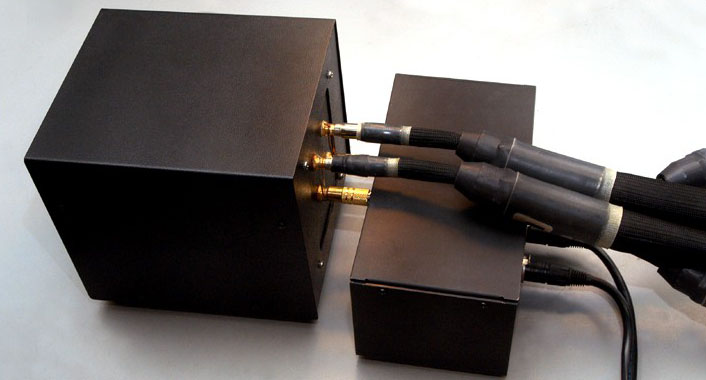
So, after all those tribulations I ended up with Expressive Technologies SU2 Transformers
driving two custom-rebuilt EAR-834PT phonostages. The letter “T” in the 834PT name
comes from the modifications proposed by Thorsten Loesch from UK. My phonostage
at that time had a few other minor changes but the basic idea of the Tim de Paravicini
design was there. From end of 2001 to approximately 2005 I was not aggressively
testing the boundaries of what I feel is possible in phonostages. I had a number
of different phonostages, starting from op-amp based and ending with huge double-chassis
filled tubes. I had better or worth phonostages and any of them that were suitable
I was trying with Expressive Technologies SU1 and SU2 magnetics. The results were
different. With some of phonostages Expressive Technologies worked better with another
it was juts more gain with no “improvement” of Sound. Sure with any phonostage the
SU1 and SU2 provided the necessary gain but I did not see that “magic” that Expressive
did with 834PT. It was no surprise that after any phonostage I tried I returned
back to my SU2+2x834PT. Taking about that sense of the basic Murrayness…
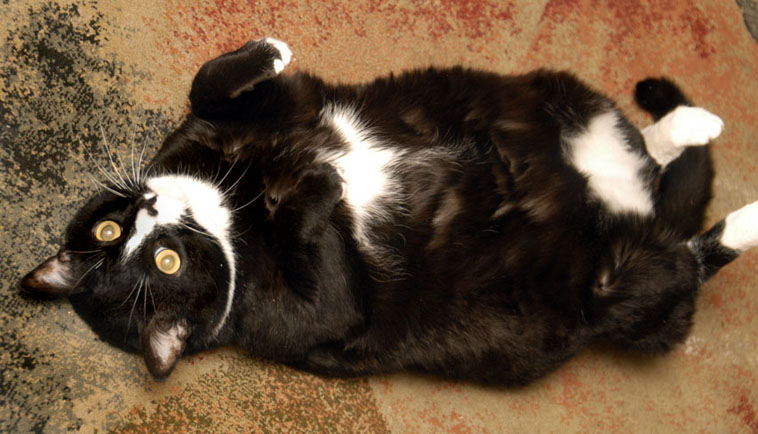
I have to admit that SU2+2x834PT has own signature (that I like a LOT) - it
tends to make me to prefer music to be played slower. The Sound kind of flows gracefully
between the phrases and if it is attractive Sound then I do not what to speed it
up but rather to hold and prolog this leisurely motion, tasting and experiencing
the event in it’s full beauty. This is very interesting quality – it feels like
music is measurably slower but this slower presentation comes from the fastest and
more dynamically-violent phonostage that I have even seen. Surprisingly the
only another phonostage that I had tried that had the same “intelligently-slower
pace” was Boulder 2008. I said “surprisingly” because Boulder’s amps are remarkable
garbage, the phonostage however is not. The Boulder phonostage had extremely good
connectivity between the sounds and very-very sophisticated top end - very few phonostages
go there. However, the SU2+2x834PT turned out to be more dynamic with more interesting
bass. The Boulder’s bass’ notes were elastically-predictable and almost algorithmable,
the SU2+2x834PT’s bass was very erratic and absolutely random.
In my search for “interesting phonostage results” I went further and asked myself
if it is possible to use all the Tim de Paravicini’s brilliant idea and to have
a fully-active phonostage. The brilliance of Mr. Paravicini’s idea was that he did
not fight with tube’s Miller’s capacitance but he made Miller’s capacitance to work
BENEFICIALLY for the objectives of RIAA correction. The 834P is pretty much a circuit
that amplifies the 12AX7’s Miller capacitance and uses it for writing the RIAA curve.
The idea to run feedback to high impedance and use very-very small complimentary
caps turn out to be so attractive that in the fully-active phonostage version was
used the very same Paravicini’s idea: the 7788 drove 7721 with the 834P-like feedback.
It was 68db of gain with 2 stages only, it had superbly low noise (it is hard to
beat 7788 for transconductance /noise) and it has very interesting output driver
(I kind of attribute “discovery” of 7721 as a driver to myself as did not
see this tube was used before, sure it was but out of my knowledge). The 7788-7721
phonocorrector was designed by Dmitry Kereev (Dima), it was very slick design and
I might post the circuit as I did not see a lot of people go for 2-stages MC level
active phonostages, and it is shame. The fully-active phonostage was absolutely
superb; in fact it still is fully operational and in service. It has very clean
sound and used air capacitors. The phonostage is good for .7-3mV cartridges in my
system as I like of my phonostages to have a LOT of “reserved” gain. (I also have
no gain in preamp). It is extremely good phonostage; if I have no SU2+2x834PT….
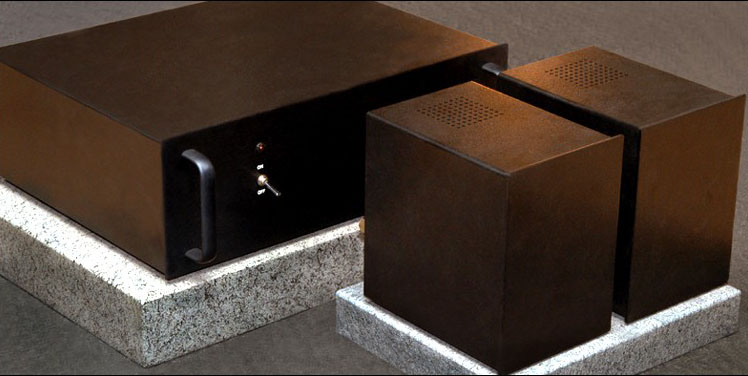
The 7788-7721 phonostage has the same sonic quality that practically any other phonostage
has. I am talking about that said fact most phonostages out there with increase
of volume turn to sound different (mostly thinner). I call this phenomena “The Limited
Curve Effect” ™. It is like playing tennis when in order to increase speed
of a strike a player needs to minimize the non-linear curvature of the paddle’s
travel. It is possible to maintain the full curve of paddle’s travel but at higher
speed but it would require much more muscle force applied not linearly but at start
and well-concentrated pulse. There are no audio components that do not suffer from
the Limited Curve Effect™. It is a question of degree. Some of audio components
are capable to produce a right amount and thin/fat quality at a given reference
volume level and at given limited tonal segment. Going up and down in volume or
in frequency those components frequently loose the harmonic integrity and begin
to sound like … electronics. Even worse: this pattern manifests itself it at all
music, effectively overriding the musical and interpretative uniqueness. So, how
the SU2+2x834PT fits in the picture? From what I have seen/heard the SU2+2x834PT
does the widest dynamic range and widest frequency range with minimum exposure to
Limited Curve Effect ™. When Sound goes up or down in dynamic or frequency
(and particularly when it goes down) then the SU2+2x834PT somehow maintains the
“full body experience”. I do not know if it is a linear process and I do not know
how and why the SU2+2x834PT tandem does it, but it does somehow. So, having my super
clean7788-7721 phonostage I still found that SU2+2x834PT more “interesting” and
more satisfying to listen, it also portrays more differences in music.
Last years my analog habits have changed. I less take pleasure in non-live performances
and I less appreciate “edited” musical events. Practically all LPs are edited and
most of them are “performances for microphone”. The last few years of dealing with
live and live-to-tape FM broadcasts and broadcast’s recordings serve and address
a lot of my listening needs and interests. As the result I spin less records and
LP became less practicable source. I still have my many thousands records and I
have my few shelves with a few hundreds records of the “best performances”. However,
the park of LPs is if not limited but rather “locked” and this limits my interest
in LP exploration. I absolutely have no interest in the reissued records as I strongly
feel that all contemporary pressed records are unspeakable garbage and those reissues
must be stuck up in the asses of the pompousidiots that produce them. So, I decided
to bring my quantitive capacity of LP playing down and squeeze out of it quality
aspect. I had double-deck turntable with 6 tonearms, a number of different cartridges,
3 phonostages with 2 huge boxes of dedicated power supplies for those phonostages…
Too much for spinning a selected record or two per week…
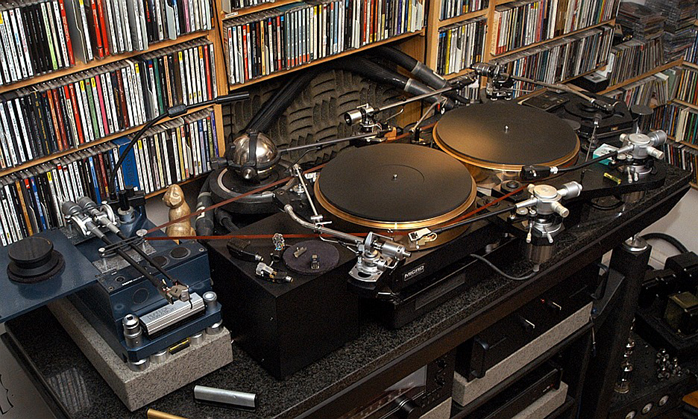
One day I looked at this and decided that it shell be different and if a one phonostage
dose right things and if I able to make all my truly necessary for me arms/needles
to work against just one load then it shell be just one phonostage. I decided to
close my book on my LP interests, taking the well-chosen limited hostages to the
rest of my analog life. I downgraded my TT to one deck and shaped out the idea of
a single “final phonostage” for myself. At that time an audio-friend of mine
was dying (or I thought he was dying) and being exposed to my thoughts about him
dying I named my “final phonostage” as the “End of Life Phonostage”. In this name
I implied the state of final being when all temptations are gone and new level of
agreeability with own understanding has opened. My “End of Life Phonostage” serves
exactly the same function to me in world of analog playback: I am with very high
confidence apatheticly-comfortable with what the “End of Life Phonostage” does and
I do not intend to spend ever any efforts challenge my comfort with this pnonocorrector.
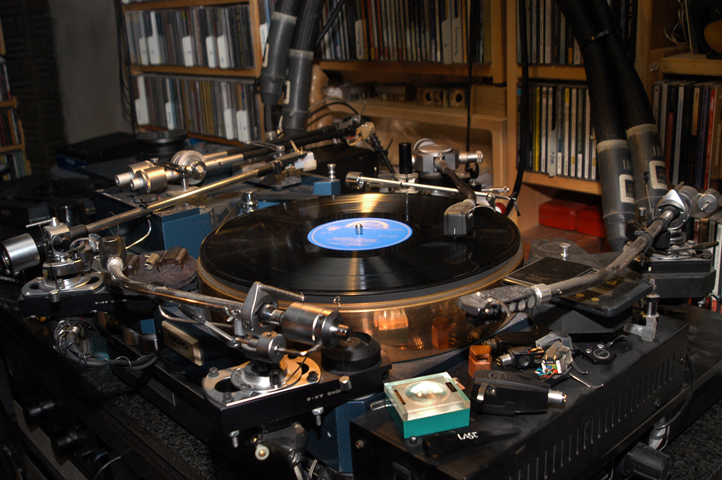
So, the “End of Life Phonostage” is basically just a re-packaged SU2+834PT phonocorrector.
It hard-binds the Expressive Technologies SU2 transformer (without external shields)
to the grid of first tube as I feel that the cable between 26dB gain step-up transformer
and phonostage shell not exist. It has better grounding schema and re-built around
thick copper plate that serves the main ground terminal. It has better power supplies,
everything uses LC filtered. It uses air capacitance (a major plus) for the Paravicini-type
RIAA correction. It is re-built with better construction techniques, better
parts. It has special I/0 layout that made to the specifics of my TT setup – this
is superbly important for me as I decided do not compromise sound by switching the
MC signal but rather to re-plug the cables from my 3 remaining reference arms. (Whoever
dealt with PAD Dominos cables know how important for anybody who use the cables
that the RCA hole to be exactly where it is most desirable for it to be)
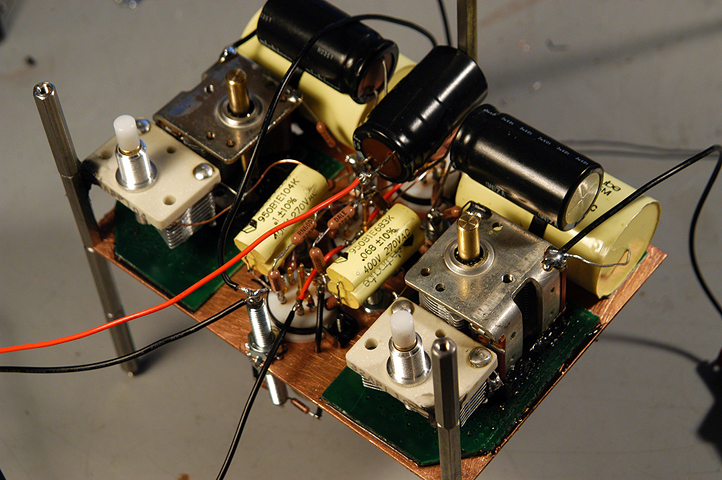
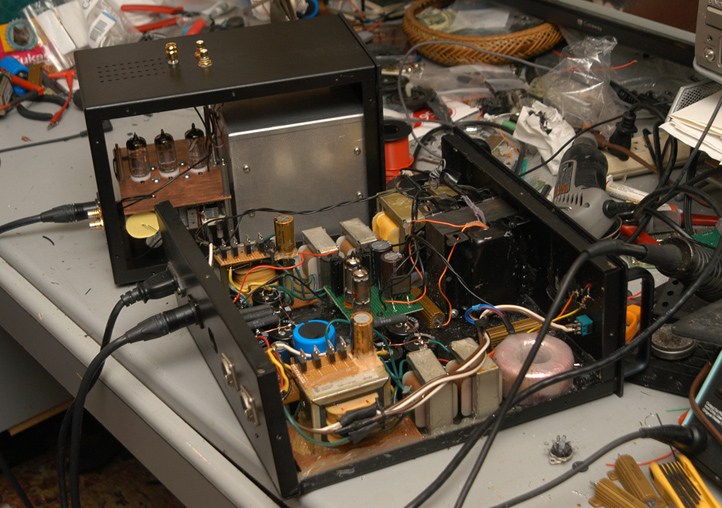
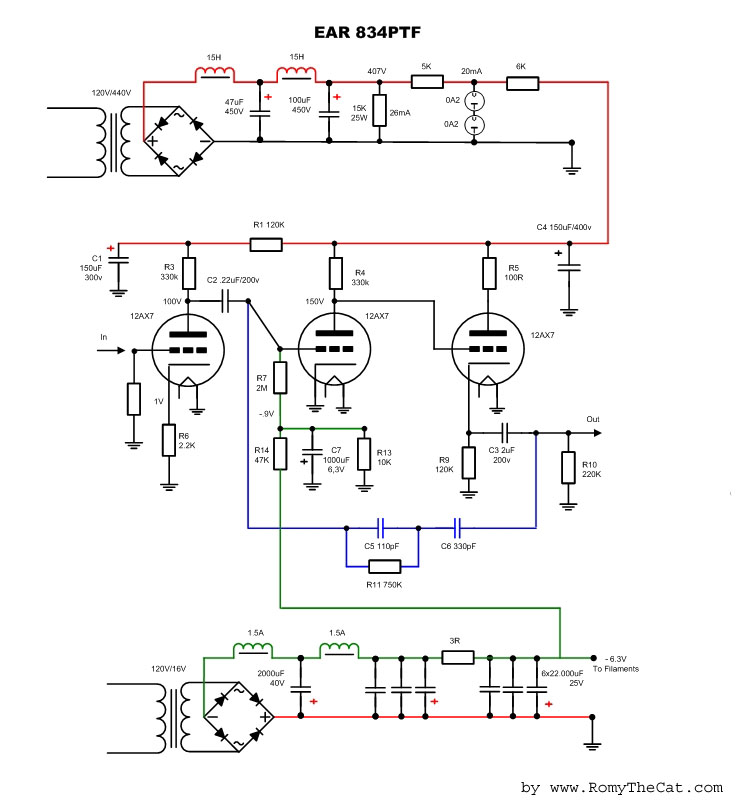
Well, this is all about the “End of Life Phonostage”. In the control unit sits right
next to the TT, has RCA hole atop and has 3 cables from 3 tonearms hanging right
to it. I might switch the cables without stressing them or myself. My “End of Life
Phonostage” has 37K loading resistor that make my Ortofon SPU Classic, Ortofon Jubilee
and Ortofon Mono loaded to 54R, it might be slightly on lower side for others but
I am comfortable with this loading. The only thing that might make me to think about
re-packaging this phonocorrector would be if I change my turntable and my layout
of the arms will changes. Will, I have a lot of reasons to feel that that I will
not change my turntable for …. the rest of my life…
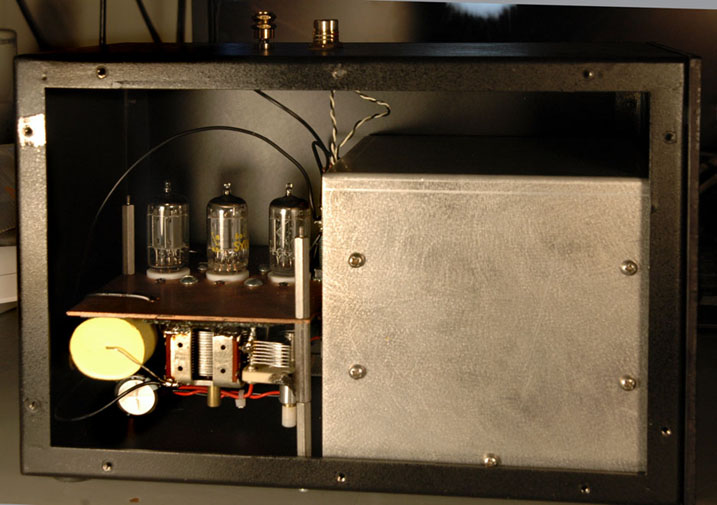
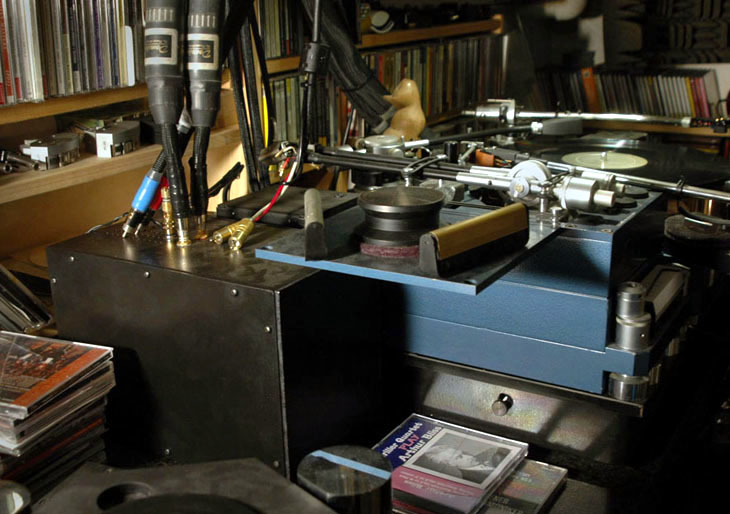
|